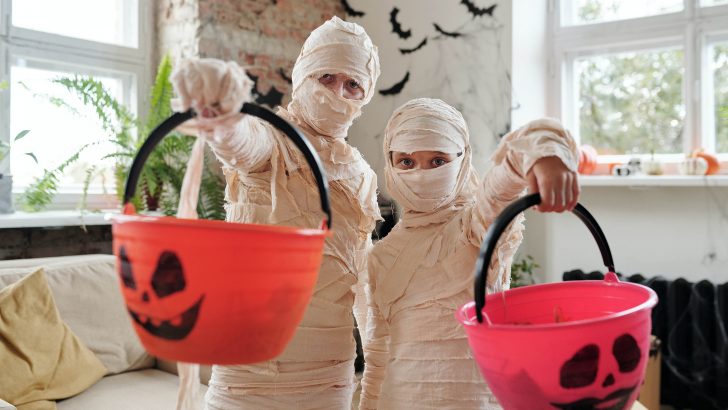Whether of pagan or Catholic origins, Hallowe’en is more than a commercial holiday writes Ruadhán Jones
An infrequent and unofficial “battle”’ takes place between Christians, Neo Pagans and sometimes New Atheists. It comes to the fore every time we have a major feast in the Church. Easter and Christmas, it is erroneously claimed, originated in pagan festivals which the Catholic Church merely “baptised”.
While these are quite spurious claims, the battle for Hallowe’en is rather more nuanced, with arguments for either side. It might seem bizarre to a Christian to even suggest that Hallowe’en is a Catholic holiday, saturated as it has become by images of ghouls, sorcery and pop culture iconography.
In Ireland, it’s well-known that the Celts celebrated the festival of Samhain to mark the end of the harvest and the beginning of winter. October 31 was a night when the spirits of the dead might roam freely and special bonfires were lit to ward them off. The Romans also celebrated a festival in this time in honour of their goddess Pomona, a patroness of fruits and gardens.
Origins
But then there’s the fact of its name, Hallowe’en – the vigil of All Hallows (also known as All Saints) day. Hallowe’en as we know it today is, or was, a largely Christian holiday which incorporated elements of Samhain and similar celebrations.
While we we can find a number of “baptised” customs in Halloween, Catholics can proudly say that Halloween is a Catholic holiday. It’s development relates to the that of the solemnity of All Saints, first celebrated in the 7th Century and moving to November 1 in the mid-9th Century.
Scholars still debate whether Pope Gregory IV moved the holiday to deliberately “baptise” a pre-existing pagan holiday or if it was merely a matter of convenience, the harvest time guaranteeing more food for pilgrims. What is certainly true is that a celebration much like our Hallowe’en, with bonfires and feasting on apples and nuts and harvest fruits, was part of pagan worship for centuries.
Whether the Church baptised these customs or not, “their coincidence shows again how alike men are when they seek God and His ways, give praise, use the language of symbols to express the inexpressible”, writes Mary Reed Newland in her excellent book on liturgical history, activities and recipes, The Year of Our Children (1956).
Ways to celebrate
Steeled with the knowledge that Hallowe’en’s origins bely the simplistic claims of Neo Paganists, what then are the best ways to celebrate? There are a number of choices: you could choose to entirely emphasise the Catholic elements; you can integrate them with the secular ones; or you can have a Halloween lite.
In my family, we generally took the last approach. Being out in the country, we didn’t have anywhere to trick or treat, but we always enjoyed the drama and creative energy that went into fancy dress. Ghosts, cowboys and a healthy dose of kitsch vampires were as far as we went.
It is clearly the case that costumes range from spooky to the extreme, from superheroes and ghosts to witches, sorcerers and gruesome creatures. But this need not be the universal experience. The costumes can also be used to fuel children’s imaginations with a more wholesome end in mind.
Wholesome costumes
Here is an example of a costume idea which is cheap, cheerful and wholesome. A popular costume in my house was dressing up as a hobbit from The Lord of the Rings. Given the good nature of the creature and the Catholic overtones of the story, this makes it an ideal choice for Hallowe’en. The costume is doubly useful as it can be used for a girl or a boy with just minor adjustments. What you will need are:
- Loose pants or a flowing skirt – save up a pair of slightly oversized, old pants, cut them just below the knee and you’re halfway to being a hobbit. If it’s for adult kids, you may have to be more creative and scout around second-hand shops for the right fit.
- An old white shirt or blouse – hobbit shirts are a little loose, so a blouse is best, but whatever you have!
- Hobbit feet are technically a part of the costume, but I would cheat on this and recommend a pair of slightly oversized shoes. Not too oversized though, they’re not clowns!
The last item you will need is a brown, green or red piece of fabric for a cloak – an old curtain is ideal for this. This is the only part which requires much effort. First, hem it all round into a large square or rectangle. The size will depend on the size of the person wearing it, so measure length from the front of the neck, over the shoulder and down to about the same length as the bottom of the cut-off pants, then add on about another 12” for the hood.
Take the material at the top end of the rectangle or square, half it over on itself, and sew together. This will form the hood that you want to sit on the shoulders and top of back of the person wearing the cloak. Use a safety pin to hold the cloak in place around the neck at the front. You can add a special touch here by placing a belt buckle or ornate metal brooch over the top of the safety pin. And there you are, your very own hobbit.
Delicious dishes
With trick or treating likely to be curtailed this year due to you-know-what, our celebrations will largely have to be confined to our homes. But the virtue of Hallowe’en is that it draws on a variety of different traditions from a variety of cultures. Here in Ireland, the predominant cultural reference is of course Samhain. But without realising it, we draw on traditions from England, America and even Rome.
This Hallowe’en is an opportunity to explore these different traditions and perhaps to revive old one which have gone out of favour. Barmbrack is perhaps the best known of the Irish traditions, but one which I discovered recently is boxty pancakes, a recipe typically associated with St Bridget.
Boxty pancakes are essentially potato pancakes and in texture are close to American style pancakes, though not in taste. They are simple to make and very filling, with a creamy taste and texture.
The ingredients are:
- 225g freshly cooked potatoes
- 225g peeled raw potatoes
- 270g white flour
- 1/2 teaspoon or 1/4 teaspoon bicarbonate of soda
- 235-350ml buttermilk
- pinch of salt (optional)
- butter for frying
The recipe is as follows:
- Peel the cooked potatoes while still hot and mash in a bowl.
- Grate the raw potatoes and add to the mash with the sieved flour and soda. Add salt if desired.
- Mix well and add enough buttermilk to make a stiff batter.
- Heat a frying-pan, grease with butter and cook large or small pancakes in the usual way.
- Eat the pancakes straight from the pan with butter, crispy rashers or pure Irish honey.
Whatever way you choose to celebrate, I hope you have a wholesome, happy Hallowe’en!


 Ruadhán Jones
Ruadhán Jones
